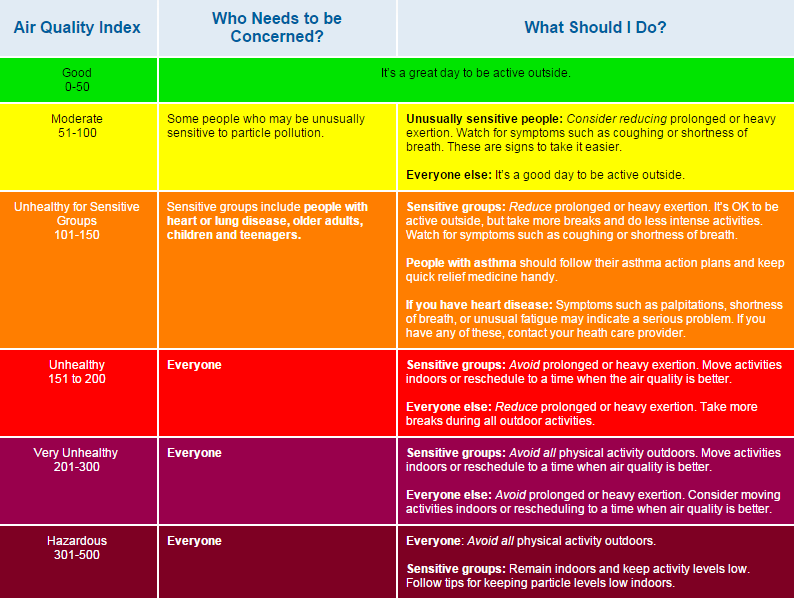How to use the HeatRisk Tool and Air Quality Index
Use these tools to help patients manage their health on hot days or days with poor air quality.
HeatRisk and the Air Quality Index provide information that can help your patients take actions to stay safe on hot days or days with poor air quality. These tools can provide your patients information to know when hot outdoor temperatures (HeatRisk) or poor air quality (Air Quality Index) may pose a risk to their health. Educating patients and caregivers about these tools can help ensure they can effectively use the information provided.
HeatRisk is a health-based heat forecast. It integrates health and temperature data to deliver a 7-day outlook for hot weather. HeatRisk uses a 5-level scale to indicate how risky the heat level is in a specific area. Each level uses a color to represent risks from heat exposure.
HeatRisk accounts for unique relationships
- between heat and health at the local level,
- in different locations, and
- at different times of year.
HeatRisk also accounts for the role of humid air, which can amplify heat-related health risks.
HeatRisk was developed by the National Oceanic and Atmospheric Administration (NOAA)’s National Weather Service (NWS) and the Centers for Disease Control and Prevention (CDC).
|
Category |
Risk of Heat-Related Impacts |
Who/What is at Risk? |
How Common is this Heat? |
Actions to consider taking at this HeatRisk level |
| Green (number 0) |
Little to none | No elevated risk | Common | It might not be hot today, but you can get ready for warmer weather by learning about heat and your health
Check the air quality in your area before heading out. |
| Yellow (number 1) |
Minor | Those who are sensitive to heat (e.g., people with severe chronic disease or limited mobility). | Common | Stay hydrated. Stay cool.
If you are very sensitive to heat, consider additional ways to stay cool. Work with your doctor to see if you need to take additional health actions. Check the air quality in your area before heading out. |
| Orange (number 2) |
Moderate | Healthy individuals with prolonged heat exposure.
Heat-sensitive individuals (e.g., people with moderate or severe chronic illness and/or limited mobility). Healthcare facilities may see increased demand, including emergency department (ED) visits |
Fairly common in most locations
Very common in warmer regions of the country |
People who are outside for a long time or who are sensitive to heat could have health impacts. Even a few hours in a cool location can lower your risk for health problems from heat.
In addition to actions for yellow, consider: If you are outside, especially for a long time, you can:
When you are indoors, you can:
Check on your family, friends, and neighbors, especially if they have chronic medical problems or live alone. Check on pets. Work with your doctor to see if you need to take additional health actions. |
| Red (number 3) |
Major | Most people
Workers, athletes, unhoused individuals, and others with prolonged exposure to heat and/or sun outdoors. Health facilities likely to see increased demand with increases in ED visits. Power outages can occur, affecting individuals who rely on electricity-powered medical devices and refrigerated medications. |
Uncommon in most locations
Fairly common in warmer regions of the country. |
This level of heat can lead to health impacts for everyone. Take steps to protect yourself and your family.
Even a few hours in a cool location can lower your risk for health impacts from heat. In addition to actions for yellow and orange, you can consider: If possible, consider moving outdoor activities to a cooler day. If you have to be outside, stay in the shade as much as possible. |
| Magenta (number 4) |
Extreme | Everyone
Health systems highly likely to see increased demand with significant increases in ER visits. Power outages can occur, affecting individuals who rely on electricity-powered medical devices and refrigerated medications. |
Rare in most locations
Occurs a few times a year in warmer regions of country, especially the Desert Southwest |
This level of heat affects everyone, as the heat is very intense and can last for a long time.
Everyone can take steps to protect themselves from impacts of heat on your health. In addition to actions for yellow, orange, and red, consider: Staying cool on these days likely requires staying inside with air conditioning, if possible. If you don’t have air conditioning, consider finding a location that does. Fans may not cool you off when it is this hot outside. Even a few hours in a cool location can lower your risk for health impacts from heat. |
The U.S. Environmental Protection Agency (EPA) developed the air quality index (AQI) to communicate whether air quality is healthy. The AQI is nationally available and reflects the contribution of common air pollutants to air quality, such as ozone, particle pollution (or particulate matter), carbon monoxide, sulfur dioxide, and nitrogen dioxide.
The AQI value is based on the pollutant with the highest concentration in the air. AQI values are divided into six color-coded categories. Higher AQI values correspond to greater amounts of air pollution and greater health concerns. The Air Quality Index does not include pollen counts. This means that on some days, the Air Quality Index may be low even though pollen levels in the air are high. High pollen counts can make asthma flare in individuals with seasonal allergies.
The AQI is reported on a scale from 0 to 500. When looking at the AQI, values of 0-100 represent satisfactory air and 101-500 represent unhealthy air. For some sensitive individuals, an AQI of 51-100 may worsen symptoms of disease. Review the AQI with your patients and talk to them about how the levels may affect their health. Make a plan with your patients for actions they can take when air quality is poor.
